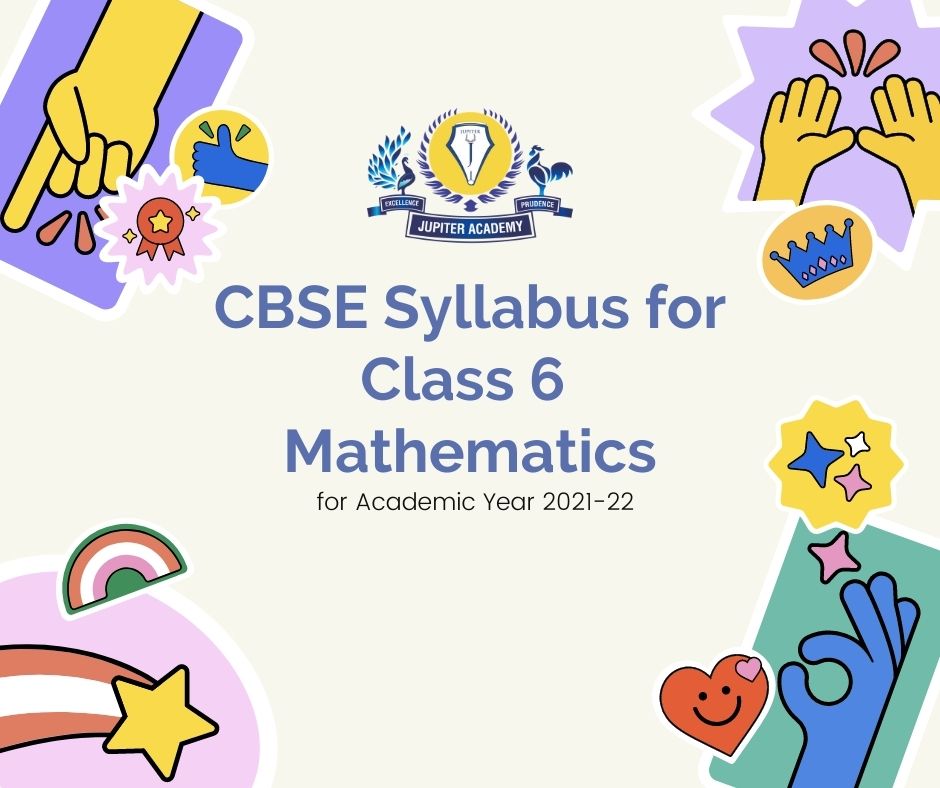CBSE Class 6 Maths Syllabus 2021-22
The CBSE has included this subject in class 6 curriculum so that CBSE Class 6 students develop analytical and thinking skills for solving problems. With the help of CBSE Class 6 Maths Syllabus, students will get a clear idea and a better understanding of the topics. Student can download the CBSE 6th Class Maths from the link below.
Thank you for reading this post, don't forget to subscribe!
Students can have a look at the topics of CBSE Class 6 Maths Syllabus below:
1) Number System
(i) Knowing our Numbers
(ii) Playing with Numbers
(iii) Whole numbers
(iv) Negative Numbers and Integers
(v) Fractions
2) Algebra
- Introduction to Algebra
3) Ratio and Proportion
4) Geometry
(i) Basic geometrical ideas (2 -D)
(ii) Understanding Elementary Shapes (2-D and 3-D)
(iii) Symmetry
(iv) Constructions (using Straight edge Scale, protractor, compasses)
5) Mensuration
- Concept of Perimeter and Introduction to Area
6) Data handling
CBSE Class 6 Maths Syllabus – Chapter Names
| Chapter 1: Knowing Our Numbers | 1.1 Introduction 1.2 Comparing Numbers 1.3 Large Numbers in Practice 1.4 Using Brackets 1.5 Roman Numerals |
| Chapter 2: Whole Numbers | 2.1 Introduction 2.2 Whole Numbers 2.3 The Number Line 2.4 Properties Of Whole Numbers 2.5 Patterns in Whole Numbers |
| Chapter 3: Playing With Numbers | 3.1 Introduction 3.2 Factors and Multiples 3.3 Prime and Composite Numbers 3.4 Test For Divisibility Of Numbers 3.5 Common Factors and Common Multiples 3.6 Some More Divisibility Rules 3.7 Prime Factorisation 3.8 Highest Common Factor 3.9 Lowest Common Multiple 3.10 Some Problems on HCF and LCM |
| Chapter 4: Basic Geometrical Ideas | 4.1 Introduction 4.2 Points 4.3 A Line Segment 4.4 A line 4.5 Intersecting Lines 4.6 Parallel Lines 4.7 Ray 4.8 Curves 4.9 Polygons 4.10 Angles 4.11 Triangles 4.12 Quadrilaterals 4.13 Circles |
| Chapter 5: Understanding Elementary Shapes | 5.1 Introduction 5.2 Measuring Line Segments 5.3 Angles-’Right’ and ‘Straight’ 5.4 Angles- ‘Acute’, ‘Obtuse’ and ‘Reflex’ 5.5 Measuring Angles 5.6 Perpendicular Lines 5.7 Classification of Triangles 5.8 Quadrilaterals 5.9 Polygons 5.10 Three Dimensional Shapes |
| Chapter 6: Integers | 6.1 Introduction 6.2 Integers 6.3 Addition of Integers 6.4 Subtraction of Integers with the help of a Number Line |
| Chapter 7: Fractions | 7.1 Introduction 7.2 A Fraction 7.3 Fraction on the Number Line 7.4 Proper Fractions 7.5 Improper and Mixed Fractions 7.6 Equivalent Fractions 7.7 Simplest Form of a Fraction 7.8 Like Fractions 7.9 Comparing Fractions 7.10 Addition and Subtraction of Fractions |
| Chapter 8: Decimals | 8.1 Introduction 8.2 Tenths 8.3 Hundredths 8.4 Comparing Decimals 8.5 Using Decimals 8.6 Addition of Numbers with Decimals 8.7 Subtraction of Decimals |
| Chapter 9: Data Handling | 9.1 Introduction 9.2 Recording Data 9.3 Organisation of Data 9.4 Pictograph 9.5 Interpretation of a Pictograph 9.6 Drawing a Pictograph 9.7 A Bar Graph |
| Chapter 10: Mensuration | 10.1 Introduction 10.2 Perimeter 10.3 Area |
| Chapter 11: Algebra | 11.1 Introduction 11.2 Matchstick Patterns 11.3 The Idea Of A Variable 11.4 More Matchstick Patterns 11.5 More Examples of Variables 11.6 Use Of Variables in Common Rules 11.7 Expressions with Variables 11.8 Using Expressions Practically 11.9 What is an Equation? 11.10 Solution of an Equation |
| Chapter 12: Ratio and Proportion | 12.1 Introduction 12.2 Ratio 12.3 Prportion 12.4 Unitary Method |
| Chapter 13: Symmetry | 13.1 Introduction 13.2 Making Symmetric Figures : Ink-blot Devils 13.3 Figures With Two Lines of Symmetry 13.4 Figures with Multiple Lines of Symmetry 13.5 Reflection and Symmetry |
| Chapter 14: Practical Geometry | 14.1 Introduction 14.2 The Circle 14.3 A Line Segment 14.4 Perpendiculars 14.5 Angles |
CBSE Class 6 Maths Syllabus 2021-22

Lorem ipsum dolor sit amet, consectetur adipiscing elit. Ut elit tellus, luctus nec ullamcorper mattis, pulvinar dapibus leo. asdasd asdawv addas sadaw afew aefewq afewq wadwe afewrw weqe sadawrv wdwq sawadw

